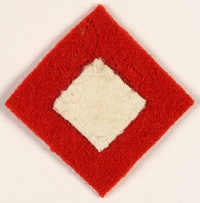The 45th Royal Tank Regiment was an armoured regiment of the British Territorial Army that fought at the Battle of Alamein during World War II and continued to serve during the 1950s.
The 43rd Royal Tank Regiment was an armoured regiment of the British Army's Royal Armoured Corps that tested and demonstrated specialised Armoured Fighting Vehicles during World War II.
The 51st Royal Tank Regiment was an armoured regiment of the British Territorial Army that fought in the Tunisian and Italian campaigns during World War II and continued to serve during the 1950s.
The 10th Armoured Brigade was a short-lived armoured brigade of the British Army in the Second World War. It had been converted in November 1941 from infantry battalions, but had never seen action and was disbanded in late 1943.

The 42nd Armoured Division was an armoured division of the British Army raised during the Second World War.

The 144th Regiment Royal Armoured Corps was an armoured regiment of the British Army. Originally raised during World War II as a battalion of the East Lancashire Regiment it was later transferred to the Royal Armoured Corps. It fought in the campaign in North-West Europe, from June 1944 to May 1945.
The 33rd Army Tank Brigade was an armoured brigade formation of the British Army raised during the Second World War.

The 148th Regiment Royal Armoured Corps was an armoured regiment of the British Army's Royal Armoured Corps during World War II. It fought in the invasion of Normandy in 1944.
The Leeds Rifles was a unit of the 19th century Volunteer Force of the British Army that went on to serve under several different guises in the World Wars of the 20th century. In World War I both battalions served as infantry on the Western Front and was later were converted into an anti-aircraft and tank unit, fighting in North Africa, Italy and Burma during World War II.
The 107th Regiment Royal Armoured Corps (King's Own) (107 RAC) was a tank regiment of the Royal Armoured Corps, raised by the British Army during the Second World War. The regiment served with distinction in North-west Europe from July 1944 to May 1945.
The 151st Regiment Royal Armoured Corps was an armoured regiment of the British Army's Royal Armoured Corps that was raised during the Second World War.
The 153rd Regiment Royal Armoured Corps was an armoured regiment of the Royal Armoured Corps, part of the British Army, and was raised during the Second World War. The regiment saw brief but intense action in the invasion of Normandy before being broken up to provide replacements to other units.
The 112th Regiment Royal Armoured Corps (Foresters) (112 RAC) was an armoured car regiment of the British Army's Royal Armoured Corps during the Second World War.
Brigadier Philip Ernest Bowden-Smith CBE, was a cavalry officer and later armoured commander of the British Army who served in the First World War and the Second World War. Described as 'one of the finest horsemen of his generation' he also represented Great Britain at the 1924 Olympic Games.
The 108th Regiment Royal Armoured Corps (The Lancashire Fusiliers) (108 RAC) was an armoured regiment of the British Army's Royal Armoured Corps during World War II.
109th Regiment Royal Armoured Corps (The Lancashire Fusiliers) (109 RAC) was an armoured regiment of the British Army's Royal Armoured Corps during World War II.
The 143rd Regiment Royal Armoured Corps was a short-lived armoured regiment of the British Army's Royal Armoured Corps during World War II.
The 110th Regiment Royal Armoured Corps (Border Regiment) (110 RAC) was an armoured regiment of the British Army's Royal Armoured Corps raised during the Second World War.
The 142nd (Suffolk) Regiment Royal Armoured Corps was an armoured regiment of the British Army's Royal Armoured Corps that was raised in World War II and saw active service. The regiment served in the final stages of the North African Campaign at Tunisia and later served during the Italian Campaign from 1943 until early 1945 when it was disbanded.
The 93rd Light Anti-Aircraft Regiment was an air defence unit of the British Army's Royal Artillery (RA) during World War II. Elements of the regiment landed with special equipment on D-Day, and served in the Normandy campaign. The regiment went on to defend Belgian cities against V-1 flying bombs and participated in the assault crossing of the Rhine.


